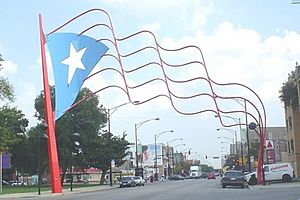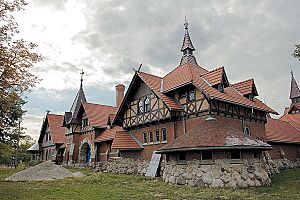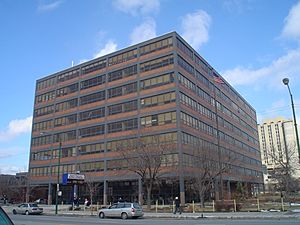Puerto Ricans in Chicago facts for kids
Puerto Ricans in Chicago are people who live in Chicago and have family roots in the island of Puerto Rico. For over 70 years, they have helped shape the city's economy, community life, and culture. Chicago is known for having many different cultures, and Puerto Ricans are a big part of that.
Contents
History of Puerto Ricans in Chicago
The story of the Puerto Rican community in Chicago goes back more than 70 years. The first people came in the 1930s, not directly from Puerto Rico, but from New York City. Many of them settled on State Street near downtown hotels. However, only a small number of people moved during this time.
A much larger group of people arrived in the late 1940s. They mostly settled in the La Clark neighborhood, which was north of downtown Chicago around Dearborn, La Salle, and Clark Streets. Companies like Castle Barton Associates hired these new arrivals to work in factories and as housekeepers for low wages. As these first migrants got settled in Chicago, many of their spouses and families joined them. In the late 1950s, the building of the Kennedy Expressway split the Puerto Rican neighborhoods of Wicker Park and Lincoln, which used to be connected.
In the 1960s, city projects forced the Puerto Rican community in Chicago to move from their homes. They relocated to areas like Old Town, Lincoln Park, Lakeview, Wicker Park, West Town, and Humboldt Park on the city's West Side. They first settled in Lincoln Park. But as the city started to make Lincoln Park more expensive and change its character (a process called gentrification), the Puerto Rican community moved further north and west. Some also settled in Lawndale on the West Side.
The Division Street riots, which happened from June 12 to 14, 1966, were a major urban rebellion by the Puerto Rican community in Chicago. These events happened around the same time the Chicago Police Department was trying to prevent unrest like what had occurred in other cities.
In 1977, there was another conflict between the Puerto Rican community and the Chicago Police Department during the Humboldt Park riot.
| Year | Puerto Rican population in Chicago |
% of Chicago total population |
|---|---|---|
| 1980 | 112,074 | 3.7% |
| 1990 | 119,866 | 4.3% |
| 2000 | 113,055 | 3.9% |
| 2010 | 102,703 | 3.8% |
| 2020 | 93,193 | 3.3% |
Present Day Puerto Rican Community
The Puerto Rican community in Chicago is well-known for its strong presence and community involvement. With support from the community, Puerto Rican leaders in Chicago were able to use the historic Humboldt Park stables near Paseo Boricua. This building now houses the Institute of Puerto Rican Arts and Culture. The building was renovated with about $3.4 million for the outside and another $3.2 million for the inside in 2006. The Puerto Rican Arts Alliance has also grown and opened a second location in Avondale. It is in a former firehouse at Central Park and Elbridge Avenues.
According to the 2020 census, there were 93,193 people in Chicago with full or partial Puerto Rican heritage. This made up 3.3% of the city's population. This number is a bit lower than the 102,703 people counted in 2010. More than half of Puerto Ricans in Illinois (53%) now live outside of Chicago. About 109,351 individuals live in other parts of the state, out of a total of 207,109.
The number of Puerto Ricans in Chicago has decreased for several reasons. These include fewer job opportunities, more competition from new immigrants, higher crime rates, and the high cost of living. Also, gentrification has changed some neighborhoods. Some families move because of the weather, or their children move to the suburbs or other states. Another reason is that more Puerto Ricans are marrying people from other backgrounds.
Within Chicago, the remaining Puerto Rican community mostly lives on the northwest side of the city. The largest groups of Puerto Ricans can be found in the community areas of Humboldt Park, Logan Square, Hermosa, Avondale, Austin, Belmont Cragin, Portage Park, and West Town. Humboldt Park is considered the main cultural and business center. Areas right north and west of Humboldt Park have the most Puerto Ricans in the Chicago area, based on the 2020 Census. Many Puerto Ricans also live in Chicago's suburbs, including Berwyn, Waukegan, Aurora, Cicero, and Elgin.
Paseo Boricua: A Cultural Hub

Paseo Boricua is a special street section on Division Street in the East Humboldt Park area of the West Town neighborhood. It represents the Puerto Rican community in Chicago. It stretches between Western Avenue and California Avenue. Paseo Boricua is known as the only officially recognized Puerto Rican neighborhood in the United States. This makes it unique, as even New York City does not have such a designated area.
The most noticeable features of Paseo Boricua are two huge, 59-foot-tall steel Puerto Rican flags. They stand like gateways at each end of the street. Many businesses in the area are named after towns in Puerto Rico. The street itself is dedicated to showing Puerto Rican pride and has a walk of fame honoring famous Puerto Ricans.
The Paseo Boricua neighborhood in Humboldt Park is very important. It is the main Puerto Rican area and acts as the political and cultural center for the Puerto Rican community in the Midwest.
Over time, Paseo Boricua has become a place where Puerto Ricans can learn about and connect with their heritage. A culture center has been built, and local Puerto Rican politicians have moved their offices to Division Street. The City of Chicago has also given money to help restore the fronts of buildings along Paseo Boricua.
Visitors to Paseo Boricua can enjoy the lively atmosphere. You can hear salsa, reggaeton, bomba, plena, and merengue music playing in the streets. The delicious smell of Puerto Rican beef stew (carne guisada puertorriqueña) fills the air. Some grocery stores in the area specialize in selling hard-to-find products from Puerto Rico, like green pigeon peas (gandules verde), sazón seasoning, and sour oranges (naranja agria).
Paseo Boricua looks beautiful with its many colorful and historically important murals. There are also two affordable housing buildings with designs that look like the old Spanish colonial styles of Old San Juan. Near the high school named after Puerto Rican baseball star Roberto Clemente, there is a tile mosaic honoring him.
In June 2024, the part of the Humboldt Park neighborhood in Chicago known as Puerto Rico Town or Paseo Boricua officially changed its name to Barrio Borikén.
Puerto Rican Parade and Festival
The Puerto Rican Parade Committee of Chicago has been helping the community for over 40 years. The festival held in Humboldt Park is now in its 48th year. It has grown to be the largest Latino festival in both Chicago and the Midwest, attracting many people.
Education and Community Schools
According to Gina M. Pérez, who wrote "The Near Northwest Side Story: Migration, Displacement, and Puerto Rican Families," Roberto Clemente Community Academy in Chicago is often called "the" Puerto Rican high school. In Jennifer Domino Rudolph's book, "Embodying Latino Masculinities: Producing Masculatinidad," she says that the school is strongly linked to Puerto Rican cultural pride.
Ana Y. Ramos-Zayas, the author of "National Performances: The Politics of Class, Race, and Space in Puerto Rican Chicago," mentions that the news media has described the school as "the property of Puerto Rican nationalists" and as being connected to Puerto Rico.
Gallery















